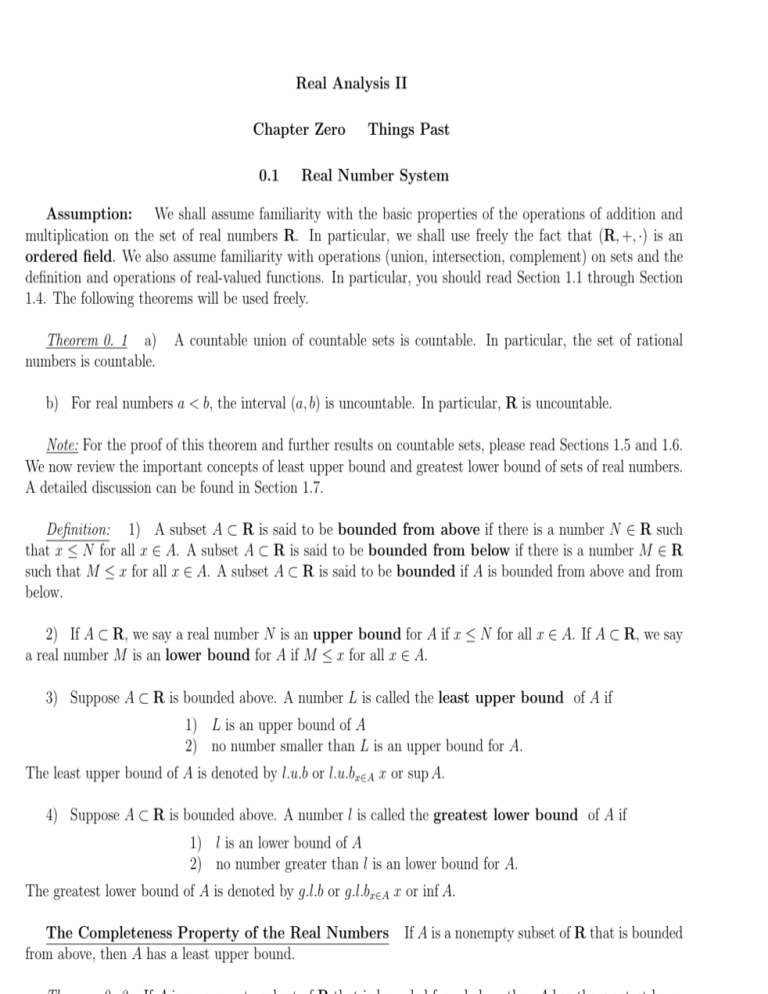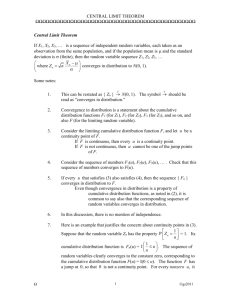Real Analysis II Chapter Zero Things Past 0.1 Real Number System
advertisement

Real Analysis II
Chapter Zero
0.1
Things Past
Real Number System
Assumption:
We shall assume familiarity with the basic properties of the operations of addition and
multiplication on the set of real numbers R. In particular, we shall use freely the fact that (R, +, ·) is an
ordered field. We also assume familiarity with operations (union, intersection, complement) on sets and the
definition and operations of real-valued functions. In particular, you should read Section 1.1 through Section
1.4. The following theorems will be used freely.
Theorem 0. 1 a)
numbers is countable.
A countable union of countable sets is countable. In particular, the set of rational
b) For real numbers a < b, the interval (a, b) is uncountable. In particular, R is uncountable.
Note: For the proof of this theorem and further results on countable sets, please read Sections 1.5 and 1.6.
We now review the important concepts of least upper bound and greatest lower bound of sets of real numbers.
A detailed discussion can be found in Section 1.7.
Definition: 1) A subset A ⊂ R is said to be bounded from above if there is a number N ∈ R such
that x ≤ N for all x ∈ A. A subset A ⊂ R is said to be bounded from below if there is a number M ∈ R
such that M ≤ x for all x ∈ A. A subset A ⊂ R is said to be bounded if A is bounded from above and from
below.
2) If A ⊂ R, we say a real number N is an upper bound for A if x ≤ N for all x ∈ A. If A ⊂ R, we say
a real number M is an lower bound for A if M ≤ x for all x ∈ A.
3) Suppose A ⊂ R is bounded above. A number L is called the least upper bound of A if
1) L is an upper bound of A
2) no number smaller than L is an upper bound for A.
The least upper bound of A is denoted by l.u.b or l.u.bx∈A x or sup A.
4) Suppose A ⊂ R is bounded above. A number l is called the greatest lower bound of A if
1) l is an lower bound of A
2) no number greater than l is an lower bound for A.
The greatest lower bound of A is denoted by g.l.b or g.l.bx∈A x or inf A.
The Completeness Property of the Real Numbers
from above, then A has a least upper bound.
If A is a nonempty subset of R that is bounded
0.2
Sequences
Definition 1)
In what follows, I will be the set of positive integers. A sequence S = {sn }n∈I is a
function whose domain is I.
2) A subsequence of I is a strictly increasing function N : I −→ I. We write Ni instead of N (i) and
note that if i < j, then Ni < Nj .
3) Let {nk } be a subsequence of I. Then the sequence {snk } is called a subsequence of a sequence {sn }.
4)
that
We say the sequence {sn } converges to a real number s, if for every > 0, there exists N > 0 such
|sn − s| < whenever
n > N.
In this case we write
lim sn = s
n→∞
or
sn → s as n → ∞
or simply
sn → s
If {sn } does not converge, then we say it diverges.
5) A sequence {sn } is called bounded if there exists a number M such that |sn | ≤ M for all n ∈ I.
6) We say a sequence {sn } is increasing if sn ≤ sn+1 for all n ∈ I. We say a sequence {sn } is decreasing if sn ≥ sn+1 for all n ∈ I. We say a sequence {sn } is monotone if it is either increasing or decreasing.
7) A sequence {sn } is called a Cauchy sequence if for every > 0, there exists a real number N such
that |sm − sn | < for every n ≥ m > N .
Note:
The following theorems will be used freely. For their proofs, please read Sections 2.1 through 2.7.
Theorem 0.4
sn /tn → s/t.
If sn → s and tn → t, then sn ± tn → s ± t, sn tn → st, and if tn 6= 0 and t 6= 0, then
Theorem 0.5
Every sequence has a monotone subsequence.
Theorem 0.6
If a sequence {sn } converges to s, then every subsequence of {sn } convergence to s.
Theorem 0.7 (Monotone Convergence Theorem)
A bounded monotone sequence is convergent.
Theorem 0.8 A sequence {sn } converges if and only if {sn } is a Cauchy sequence.
0.3
Definition
1)
Series of Real Numbers
A sum of the form
a1 + a2 + a3 + · · ·
P
P
is called an infinite series and is denoted by ∞
an . The sum
n=1 an or simply
sn = a1 + a2 + · · · an
P
is called the nth partial sum of the infinite series. We say the infinite series an convergence to a real
P
number s if the sequence of partial sums {sn } converges to s. In this case, we write s = an .
P
2) We say an convergence absolutely if
P
then we say an converges conditionally.
3)
Suppose an > 0 and bn > 0. We say
Note:
P
P
|an | convergence. If
an is dominated by
P
P
an convergence but
P
|an | diverges,
bn , if an ≤ bn .
The following theorems will be used freely. For their proofs, please read Sections 3.1 through 3.6.
Theorem 0.9
If
P
an convergence, then an → 0.
P
P
(an ± bn ) and
P
P
Theorem 0.10
If
Theorem 0.11
Assume an ≥ 0. If the sequences of partial sums {sn } is bounded, then
an and
bn are convergent, then so are
(can ).
P
an is convergent.
Theorem 0.12 (Alternating Series Test) If an > 0, {an } is decreasing, and an → 0, then the alterP
P
nating series (−1)n an is convergent. Furthermore, if s = (−1)n an , then
|s − sn | < an+1
for all n.
Theorem 0.13
If |x| < 1, then
Theorem 0.14
If
P
P n
x
= 1/(1 − x).
an converges absolutely, then
P
an converges.
P
Theorem 0.15 (Comparison Test)
Suppose an is dominated by
P
P
P
an converges. If an diverges, then bn diverges.
Theorem 0.16 ( Limit Comparison Test) Suppose bn 6= 0 and let
an
L = n→∞
lim
.
bn
P
P
If 0 < L < ∞, then an converges if and only if bn converges.
Theorem 0.17 (Ratio Test)
Let
r=
an+1 .
lim
n→∞ a
P
bn . If
P
bn is convergent, then
Theorem 0.18 (Root Test)
Let
r = lim
q
n
n→∞
|an |.
Then
P
1) If r < 1, then an convergence absolutely.
P
2) If r > 1, then an diverges.
3) If r = 1, then no conclusion can be drawn.
P
Theorem 0.19 If an is conditionally convergent, then for every real number x, there is a rearrangement
P
of an that converges to x.
Theorem 0.20
Let
an+1 .
r = n→∞
lim an
Then
1) If |x| < 1/r, then an xn convergence absolutely.
P
2) If |x| > 1/r, then an xn diverges.
P
3) If |x| = 1/r, then no conclusion can be drawn about the convergence of an xn .
P
0.4
Definition 1)
δ > 0 such that
Continuous Functions
We say a function f has a limit L at x = a if and only if for every > 0, there exists a
|f (x) − L| < In this case we write limx→a f (x) = L.
whenver
0 < |x − a| < δ.
2) We say f is continuous at x = a if and only if limx→a f (x) = f (a).
3) We say a function f has a limit L at ∞ if and only if for every > 0, there exists a real number M > 0
such that
|f (x) − L| < whenver x > M.
In this case we write limx→∞ f (x) = L. We define limx→−∞ f (x) = L in a similar manner. Give the technical
definition of limx→a = ±∞ and also that of the right-hand and left-hand limits.
Note:
The following theorems will be used freely. For their proofs, please read Section 4.1.
Theorem 0.21 limx→a f (x) = L if and only if for every sequence {xn } that converges to a the sequence
{f (xn )} converges to L.
Theorem 0.22
If limx→a f (x) = L and limx→a g(x) = M , then
Theorem 0.23 If f and g are continuous at x = a, then so are f ± g, f g, and f /g (provided g(a) 6= 0).
Also the composition of continuous functions is continuous.
Theorem 0.24 A function f is continuous at x = a if and only if for every sequence {xn } that converges
to a the sequence {f (xn )} converges to f (a).
Theorem 0.25 (Extreme Value Theorem or EVT)
Let f be a continuous function on a closed
bounded interval [a, b]. Then f attains both the minimum and maximum values on [a, b]. In other words,
there are points c, d ∈ [a, b] such that f (c) ≤ f (x) ≤ f (d) for all x ∈ [a, b].
Let f be a continuous function on a closed
Theorem 0.26 (Intermediate Value Theorem or IVT)
and bounded interval [a, b]. If K is any number between f (a) and f (b), then there exists a point c ∈ [a, b] such
that f (c) = K. In particular, if f (a)f (b) < 0, then f has a root in [a, b].







